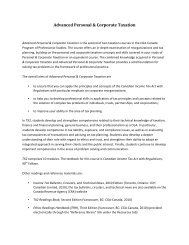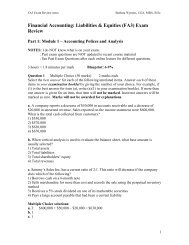CHAIR'S PROFILE - CGA Online Learning Environment
CHAIR'S PROFILE - CGA Online Learning Environment
CHAIR'S PROFILE - CGA Online Learning Environment
You also want an ePaper? Increase the reach of your titles
YUMPU automatically turns print PDFs into web optimized ePapers that Google loves.
FEATURE ▪ Human Resources<br />
Team drumming,<br />
skydiving and rock<br />
climbing are just a few<br />
of the unique teambuilding<br />
activities taking<br />
employees to new<br />
heights<br />
Attracting and keeping top employees<br />
is often the rationale behind team-building<br />
events. Doust says there’s more to teambuilding<br />
than simple retention issues but<br />
does acknowledge that there is pressure<br />
to keep ahead of the curve.<br />
Hot air ballooning, taking a comedy<br />
improv class, fire walking — just another<br />
day at work, right<br />
Not at all — and that’s the point. By<br />
taking employees out of their comfort zone,<br />
physically and emotionally, companies are<br />
counting on unfamiliarity to create deeper<br />
working relationships, particularly during<br />
reshuffling or periods of change.<br />
What companies hope to gain from<br />
team-building and what employees actually<br />
get from the experience may be very different.<br />
Professor Gerard Seijts, associate<br />
professor of organizational behaviour at<br />
the Ivey School of Business at the University<br />
of Western Ontario, suggests coherence is<br />
a key factor in an event’s effectiveness.<br />
Businesses need to make sure<br />
employees are briefed on the true significance<br />
of the action to insure the benefit.<br />
They need to answer an employee’s unspoken<br />
question: “Why the heck am I here<br />
instead of doing my job”<br />
Here, Seijts says, a good facilitator is<br />
essential.<br />
”The facilitator needs to clearly explain<br />
how [the employees] are going to take<br />
these lessons to the boardroom or onto<br />
the factory floor. If they don’t do that or if<br />
they’re not interested then it’s a waste of<br />
money.”<br />
NOT A PANACEA<br />
A trust fall — when you fall back into the<br />
arms of a colleague — may act as a dramatic<br />
metaphor for building team confidence,<br />
but the reality is that genuine trust<br />
and respect between coworkers doesn’t<br />
spontaneously develop. Professor Lynne<br />
Purvis, a psychologist who specializes<br />
in workplace issues at the University of<br />
Surrey in the U.K., points out good working<br />
relationships develop in the daily encounters<br />
and experiences of the workplace.<br />
“Team-building exercises may at the<br />
very least furnish opportunities to get to<br />
know colleagues better; however, trust is<br />
something built up over time through behaviour.<br />
If there is no infrastructure in place<br />
to support teamwork back in the workplace,<br />
then there will be no teamwork — however<br />
expensive the intervention,” says Purvis.<br />
Team-building exercises play with<br />
metaphors of the workplace, but a workplace<br />
culture needs to be built on concrete<br />
realities, such as competitive compensation,<br />
decent vacation time and investment<br />
in training and skills development, says<br />
Seijts.<br />
LOOKING WITHIN<br />
Thinking inside the box may also have benefits<br />
when it comes to team building. Daniel<br />
Torchia, managing director of Torchia Communications,<br />
a small communications firm<br />
in Toronto and Montreal, allows employee<br />
14 STATEMENTS AUGUST/SEPTEMBER 2011






